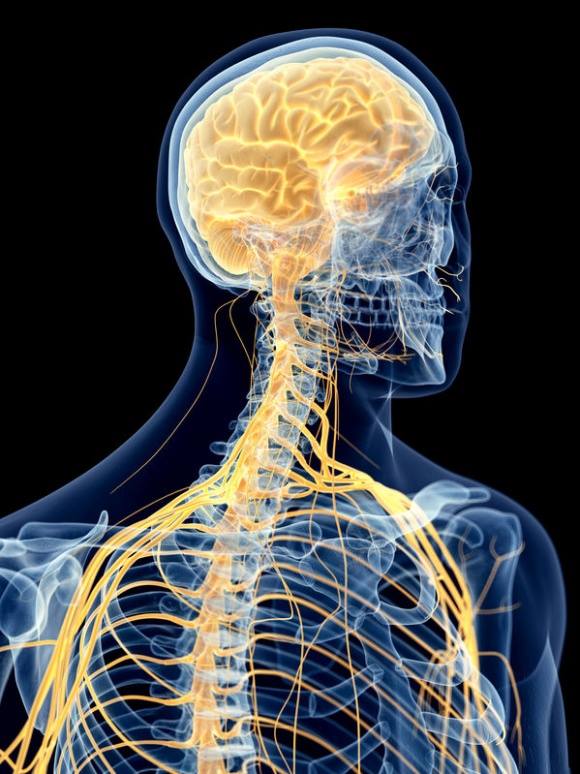Don’t Be Nervous: A Beginner’s Guide to the Human Nervous System

An Anvil T&D article by Daniel Hunt.
All information taken from current tertiary education course.
Within the human body, eleven organ systems exist and function together to maintain what is called ‘homeostasis’, which simply put - a balance in the internal environment within each of us. Our organ systems are constantly making adjustments and utilising energy to keep us alive,functioning at what is considered optimal levels - as fluids, chemicals and energy sources (just to name a few) increase and decrease with influence from external contributors. Depending on your level of knowledge on the body, you may be familiar with some of the organ systems - nervous, cardiac and respiratory are ones that get mentioned fairly often outside of the medical community (for example, in the fitness industry). These systems are fairly intuitive in their functions, as things like our reflexes, heartbeat and breathing are physical functions of which we are consciously aware. Systems the average person may be less aware of are the endocrine and lymphatic systems, which secrete hormones and combat infection respectively. Together, the eleven systems make up an organism - which, like anything that requires multiple areas to function properly, has a command centre. The command centre for the human body is the brain, and branching from the brain is the nervous system. The nervous system uses chemical and electrical signals to communicate information within the brain - where it is processed and acted upon as necessary. The process in which these electrical signals are created is quite interesting and involves the movement of chemicals within a plasma membrane. However, in the interest of simplicity, I won’t be going over that. Instead - I’ll be discussing the three components of the nervous system, and looking more closely at one of them in particular.
The Big Three
Central Nervous System (CNS)
The first thing that usually comes to mind when the nervous system is mentioned is the CNS - which consists of the brain (command centre) and spinal cord (highway along which all information travels). It’s important to note that all information passed through the nervous system can be broken up into two main types - sensory information and motor commands. Sensory information, as you may have guessed, is information gathered by our senses; such as sight, smell, hearing, taste and touch. When one of these senses are stimulated (by what’s called a stimuli), electrical messages are sent via the nervous system to the brain. The brain processes that information using different areas of the brain responsible for different forms of sensory information. To make sure we don’t become overloaded with constant sensory input, the brain makes use of regulatory processes to help us differentiate between what requires conscious attention (and what can be dealt with automatically). Sensory information is essentially our body's way of interpreting and understanding our surroundings, and we are constantly being fed information - whether we know it or not.
Once the brain has received, processed and decided what to do with information it’s been fed - motor commands are transmitted back through the nervous system and sent to the relevant area. Motor commands activate things like our skeletal muscle, so performing an action like flexing your arm is your brain telling your arm muscles to contract via a motor command. Motor functions can be voluntary (we request the action to be performed), or as a reflex response (reactive response to stimuli). Another good example of this information processing at work is accidentally placing your hand on something sharp - the sharp object acts as the stimulus, and sensory information will be sent to the brain. The brain receives the message, and fires back motor commands through the nervous system - with the likely outcome being the removal of your hand from the sharp object. Now, there’s room here to bring up the autonomic reflexes used by the body, in which you will retract your hand automatically from dangerous stimuli - without needing signalling to do so from the brain. Reflexes are a great protective feature utilised by the body, but in this article I won’t be going into depth with reflexes - but instead will give some ‘honourable mentions’ in a different section.
Peripheral Nervous System (PNS)
The peripheral nervous system is where a lot of the ‘magic’ happens. If the brain is the command centre and the spinal cord is the corridor that all information travels through to go in and out of the brain, then the PNS is the doors up and down our corridor for information. Messages are constantly coming in from the peripheral nervous system, walking up the corridor to where the command centre is situated - and coming back out with commands.

This passage of information to and from the brain is extremely fast, as you would expect from messages carried via electrochemical signals. The body uses both electrical and chemical messaging to facilitate actions within itself, however, chemical messages are slightly slower, long-term based changes. Speed is one benefit of using electrical signals, and interestingly the body evolved so that messages created by stimulus to the lower body arrive at the brain within the same amount of time as messages from the upper body - despite the difference in distance travelled.
The PNS is further broken down into two directional divisions: Afferent and Efferent. I’ll go into more detail of these components very soon.
Enteric Nervous System (ENS)
The enteric nervous system is a less spoken about component of the nervous system, but is still vital to the functioning of the human body. Referred to as the ‘gut brain’, the ENS is located within the digestive tract, and has just as many neurons (that electrically communicate with the brain) as the spinal cord. Interestingly, the ENS is able to initiate and coordinate reflexes without input from the CNS, so long as the reflex happens locally. I won’t be discussing the enteric nervous system any further, as while it’s obviously important to the nervous system and bodily function - it isn’t a focus point for this article.
Peripheral Nervous System
Here I want to discuss the peripheral nervous system, with its divisions and subdivisions. The divisions, which I briefly mentioned earlier as the afferent and efferent, are both responsible for carrying either sensory information or motor commands.
Afferent (Arrive)
The afferent division of the peripheral nervous system is responsible for carrying our sensory information, from the PNS to the CNS. Once a receptor has been stimulated, the previously discussed electrical messengers travel from the PNS and into the spinal cord, where they continue to the brain for processing. The afferent division is important for environment awareness, and is constantly working to relay information. As these afferent nerve tracts arrive in the brain, it’s fitting to use ‘A’ as a way to remember which kind of information this division carries.
Efferent (Exit)
The efferent division carries the motor commands from our brain, to the designated target location in the body. Earlier, I mentioned contracting your muscle to flex, which happens due to the electrical messengers giving instructions to the nerves located at that specific muscle. A conscious movement like flexing would fall under what is called the Somatic Nervous System (SNS), a subdivision of the efferent division.
Somatic Nervous System (SNS)
The somatic nervous system controls skeletal muscle contractions, that is for the sake of simplicity - the muscles you use each day to lift objects and move your body (e.g. quads, biceps, abs). Skeletal muscle contractions can be both voluntary and involuntary, with voluntary being something such as our aforementioned arm flex, and involuntary being reflexes. We can refer back to my earlier reflex example of placing your hand on something sharp, as to pull away the stimulated hand - certain muscles contract while others relax to allow movement. This specific reflex is known as reciprocal inhibition, which I’ll touch on briefly soon.
Autonomic Nervous System (ANS)
The autonomic nervous system, as the name suggests, controls functions which we do automatically (or, subconsciously). Contracting cardiac muscle, or the secretion of substances from our glands being examples of this. The autonomic nervous system can, however, have a large impact on one's conscious state, and involves a tonic balance between concepts many may be familiar with - ‘fight, flight or freeze’ (sympathetic) and ‘rest & digest’ (parasympathetic). It is important to note that both systems fire tonically, or at a resting rate, and when different stimuli is present - the scales of sympathetic & parasympathetic shift to help us respond appropriately.
Sympathetic (Fight, Flight or Freeze)
The sympathetic division of the Autonomic Nervous System has a stimulating effect on our bodies, increasing heart rate, breathing and other subconscious functions - reacting to perceived danger and stress being placed on the body. If you’ve ever been in a situation where you feel threatened, or even just stressed at work - you’ve likely felt the effects of the sympathetic division (increased heart rate, heavy breathing and your thinking process going at what feels like twice the speed). Increased sympathetic outflow allows the body to engage in protective behaviours - whether that be through fight, flight or freeze responses.
Parasympathetic (Rest & Digest)
The parasympathetic division is the opposite of the sympathetic, causing a relaxing effect onto the autonomic nervous system. It’s likely that we spend more time in this state unless you are in a unique circumstance such as living in a hostile environment, or working a stressful job for long hours. This relaxing effect on the autonomic system allows the body to recover, upregulates digestive activity and is necessary for maintaining a healthy state.
Reflexes
The following is a brief section on reflexes - more of an ‘honourable mention’ than a deeper discussion. Reflexes occur due to a network called a ‘reflex arc’, where sensory information is relayed to the brain, processed, and motor commands are sent back. While I’ve kept this explanation of reflexes as responses to sensory stimuli very simple , - the key difference in reflexes compared to voluntary motor action is that they are automatic, and very fast. At some point we’ve all likely experienced situations where our reflexes have acted without us meaning them to, such as our fingers touching something hot and almost instantly pulling them away - or losing balance and throwing your arms up to help stabilize. These following few examples give a general idea of the usefulness of our bodies' different reflexes.
Withdrawal Reflex
The withdrawal reflex is the cause for rapidly pulling away your hand when you touch something hot or painful. This reflex is controlled by the spinal cord, and unlike other reflexes or physical movements - the spinal cord is able to control this reflex without any input from the brain. By doing so, the body is able to respond more rapidly to potentially damaging stimuli placed on it without requiring us to consciously pay attention to it - as acting without input from the brain reduces the travel time for messages and enables a much faster reaction.
Reciprocal Inhibition
If you have some knowledge on how muscles work together to perform movements, whether in the gym or just in daily life - you may know that when one muscle contracts, another relaxes (becoming inhibited) to better allow the contracting muscle to perform. The contracting muscle is called the prime mover, or agonist - while the relaxing muscle is called the antagonist. Not only is this reflex important for efficient movement, it’s also used with protective function. If you were to step on a sharp nail, the stimuli would cause you to raise your foot so as to not further damage yourself. In this example, the quadricep muscles (agonist) would contract to bend the and raise the knee - while the hamstring muscles (antagonist) would relax.
Crossed Extensor Response
Using the same example of stepping on a sharp nail, the body does more than just raise the foot when responding. In order to raise the foot off the ground, body weight has to be removed from the side which is experiencing the stimuli - so body weight will be shifted to the other leg (contralateral side). This once again means that one or more muscles will contract, while others relax to effectively take up the weight of the body. Again, this reflex response is used by the brain to protect the body from the initial pain (the nail), and prevent subsequent systemic damage (such as falling off balance because you’ve contracted your leg).
Conclusion
The nervous system is pretty wonderful, and whilst it may be complicated - it can give a new appreciation for the underlying functions of the human body. Whether you look at it at a cellular level or at the nervous system as a whole, the reality that the body is causing tiny chemical reactions to create electrical signals as a form of communication is pretty crazy. As well as the autonomic functions the nervous system has, being aware of the influence it has on our conscious state can provide benefits for daily life - such as being aware of what kind of state we may be in (fight, flight or freeze/rest and digest) and if that state is appropriate to our surroundings and our health. Through this beginner’s guide to the components of the nervous system, I hope I’ve been able to share with you the basic system behind the way we both receive & respond to the world around us.
Train Smart. Train Hard.
About Us
Anvil Training and Development is a group of Australian veterans who care about the physical and mental health of veterans and emergency service workers. We’re passionate about ongoing education and working with others to implement positive change.
Instagram: Anvil Training & Development - @anvil.td
Facebook: Anvil Training & Development - @anvil.td
www.anviltd.com
(Article Edited, Proof Read, and Fact-Checked by Charlotte Officer)
VES Mental Health Resources: https://anviltd.com/pages/ves-australian-mental-health-resources









Well DONE Dan. I’ll write a PTSD link to fear of dying & parasympathetic “Freeze” response in ADF training near accident.
Leave a comment